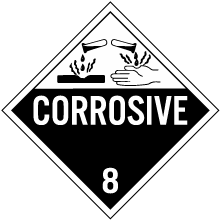See all of our Sulfuric Acid Signs
What is Sulfuric Acid?
Sulfuric acid, also called oil of vitriol, is a colorless and odorless corrosive liquid. It is a very strong inorganic acid with qualities that make it very useful for a number of industries. Its primary industrial use is to make phosphoric acid which is a main ingredient in most chemical fertilizers. Sulfuric acid is a critical component for metal manufacturing, particularly in the production of copper and zinc as well as the cleaning of steel. Other uses include detergents, lead-acid automobile batteries, and other chemicals such as hydrochloric acid, dye, explosives, pigments, and drugs. Concentrated sulfuric acid is a strongly acidic material that reacts rapidly with water, evolving considerable heat.
Sulfuric acid is corrosive, and contact can severely irritate and burn the skin and eyes and may lead to blindness. Inhaling sulfuric acid can irritate the nose, throat, and lungs. Higher exposures may cause a build-up of fluid in the lungs (pulmonary edema). Exposure can cause headache, nausea, and vomiting. Repeated exposure can cause permanent lung damage, damage to teeth, and upset stomach. In addition, sulfuric acid is reactive and a dangerous explosion hazard. It is not combustible, but it is a strong oxidizer that enhances the combustion of other substances.
Fire Protection Guide to Hazardous Materials - Edition 14th
| Chemical Name / CAS No. | NFPA 30 / OSHA Class | Health | Flammability | Instability | Special Hazard | DOT Class | ID No. |
|---|---|---|---|---|---|---|---|
| Sulfuric Acid 7664-93-9 |
None | 3 | 0 | 2 | Class 8 Corrosive Material |
UN 1830 |
Why are there different ratings for Sulfuric Acid?
The other ratings that appear on this page, besides those listed in NFPA's Fire Protection Guide to Hazardous Materials - Edition 14th above, were found in other documentation. Sulfur Dioxide, for example, has different rating than Sulfuric Acid along with DOT identification number UN 1079 for transportation. Always consult your specific chemical's SDS for more information.
NFPA 49 Chapter 5 Hazardous Chemical Data Sheet
The Hazardous Chemical Data Compilation, previously known as NFPA 49, provides guidance on the hazards of chemicals to emergency personnel, safety professionals, inspection and enforcement officials on storage and fire fighting techniques that can be used in an emergency or in disaster planning.
Name: SULFURIC ACID
Synonyms: Battery acid, chamber acid, fertilizer acid, oil of vitriol
Formula: H2SO4
NFPA 30/OSHA Classification: n/a
DOT Class: Class 8, Corrosive material
Shipping Label: Corrosive
ID No: UN 1830
CAS No: 7664-93-9
Statement of Hazards: Corrosive. Water reactive. Oleum is extremely reactive with water. Reaction with metals may produce hydrogen gas.
Emergency Response Personal Protective Equipment: Wear special protective clothing and positive pressure self-contained breathing apparatus.
Spill or Leak Procedures: Keep water away from release. Stop or control the leak, if this can be done without undue risk. Control runoff and isolate discharged material for proper disposal.
Fire Fighting Procedures: Extinguish fire using agents suitable for nearby fires. Use water spray only to keep fire-exposed containers cool.
Health Hazards: Corrosive. Causes severe eye and skin burns. May be harmful if inhaled.
Fire and Explosion Hazards: Not combustible. Strong dehydrating agent, which may cause ignition of finely divided materials on contact. Reaction with metals may produce hydrogen gas. Oxides of sulfur may be produced in fire.
Instability and Reactivity Hazards: Water reactive. Reacts with alkalies, releasing heat. Reacts with metals, releasing hydrogen gas. Reacts with picrates, chlorates, nitrates, and many other materials.
Storage Recommendations: Store in cool, dry, well-ventilated location. Separate from combustibles and other reactive materials. Separate from carbides, chlorates, fulminates, nitrates, picrates, and powdered metals.
Physical Properties: Colorless to brown, odorless, oily liquid.
Melting Point: 50°F (10°C)
Boiling Point: 626°F (330°C)
Specific Gravity: 1.84
Solubility in Water: Soluble
Transport Information
Hazmat Placards are required for the transportation of sulfuric acid. In the US, the Department of Transportation classifies sulfuric acid as a hazard class 8. Corrosive material (Class 8) means a liquid or solid that causes irreversible damage to human skin at the site of contact within a specified period of time. A liquid, or a solid which may become liquid during transportation, that has a severe corrosion rate on steel or aluminum based on the criteria in §173.137(c)(2) is also a corrosive material.
| Hazardous Material | Classification | UN Number | Hazard Class | Packing Class |
|---|---|---|---|---|
| Sulfuric Acid (with more than 51% acid) | DOT US Department of Transportation |
UN1830 | 8 | II |
| Sulfuric Acid (with no more than 51% acid) | DOT US Department of Transportation |
UN2796 | 8 | II |
| Sulfuric Acid (spent) | DOT US Department of Transportation |
UN1832 | 8 | II |
§172.558 Corrosive placard.
(b) In addition to complying with §172.519, the background color on the CORROSIVE placard must be black in the lower portion with a white triangle in the upper portion. The base of the white triangle must be 38 mm ±5 mm (1.5 inches ±0.2 inches) above the placard horizontal center line. The text and class number must be white. The symbol and inner border must be black.

